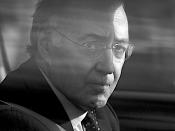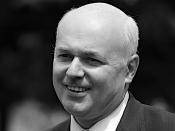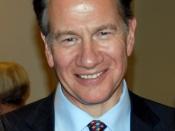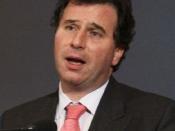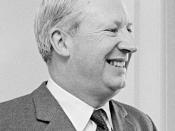The Organisation and Membership of the Conservative Party This report looks into the make-up of the Conservative Party, how the different departments link up and its membership.
The Conservative Party is the oldest of the current major political parties, and has been in power, either as a stand-alone or coalition government, for the majority (two thirds) of the years since the end of the First World War.
Following the massive landslide election defeat in the summer, William Hague resigned as party leader. There followed a closely fought leadership battle between favourites Michael Portillo, Kenneth Clarke and Iain Duncan-Smith, from which Duncan-Smith emerged the eventual winner. Other key figures in the shadow cabinet include Michael Anchram as Shadow Secretary of State and deputy leader, Michael Howard as Shadow Chancellor of the Exchequer and David Davis as party chairman. There were 166 Conservative MP's voted in during the last general election.
There are many different groups and institutions that make up the Conservative Party Organisation. Firstly we have the 1922 committee. This is the Conservative MP's own association, which elects all its own officers and executive committee. It only deals with the Party Leader by invitation, and is where Iain Duncan-Smith made his debut address to the party shortly after his appointment. Traditionally strongly supporting Party Leaders (at least publicly), this committee has considerable influence within the party, and ""æConservative leaders, if they are wise, take care never to ignore the advice of the 1922 committee"à(Jones et al 2001: 241). There are a number of other committees within the Conservative Party focusing on matters relating to policy or regional groupings. Whilst being slightly peripheral in opposition, when in government these committees can be very influential with regards to policy making.
A further crucial part to the organisation of the Conservatives is the annual conference. Although the conference no longer decides on any policies, it is important to the Party as a way of communicating to members and lesser party officials. It gives a broad overview of key policies, and allows the party leader to address his party as a whole. This is important because it shows other parties and the country as a whole the unity and togetherness of the party. Also analysts can gauge the mood of members with regards to new legislature or policy changes that might first arise at the conference.
The Conservative Party, like Labour and the Liberal Democrats has a central office from which the party as a whole is linked up, from activists in the country to ministers in Westminster. Central office comes under direct control of the party leader, and it is from here that general election campaigns are planned and monitored.
Within the Conservative Party there are several different Party Groups. These are collections of like minded MP's who have formed a group between them to further certain beliefs or key policies. The first group of this kind was the Primrose League, which was formed in 1883 to "..Advance the Liberal Conservatism of Disraeli and encourage social contact amongst grass roots membership."ÃÂ (Jones et al 2001: 242). Another famous group is the Bow group, founded in 1951,and today has around 30 MP's nationwide. The Bow Group describes itself as a "centre right think tank"ÃÂ, with its aims being to develop policy, publish research and to stimulate debate within the Conservative party (www.bowgroup.org: 05/11/01).
The Conservative Party is funded mainly by the private sector. The vast majority of their income comes from private sponsors or businesses, with the remainder coming from charges to local constituency associations. In recent years, the Conservative Party has experienced severe financial pressures, owing to a sharp decrease in funding. This has been attributed to the recession from 1987 onwards, and more recently owing to the stance taken by the Party on matters relating to the EU and single currency.
The membership of the Conservative Party has been affected by the growing apathy throughout Britain towards Politics. In the early 1950's, the Conservative party membership was estimated at 2.25m, but current levels are less than 350,000. Also the Party is facing a problem with regards to the age of their members. The average age of a member is 62, and only 5% of members are under the age of 35. Party members are less active than in former times, with three quarters of members doing no work for the party in an average month, compared to half of Liberal Democrat members and less than two thirds of Labour members. In summary, in the 1960's, the Conservative party membership was three times bigger than that of Labour and more active, whereas now it is smaller and less active. (Seyd & Whiteley) Word Count: 750 words approximately Biblioraphy Jones et al 2001, Politics UK Edition 4 C Pilkington 1998, Issues in British Politics Guardian: "Slow Collapse"ÃÂ 05/11/01 www.politics.guardian.co.uk/archive/article/o..3909276.00.html Conservatives: www.conservatives.com Bow Group: www.bowgroup.org

